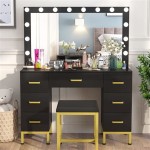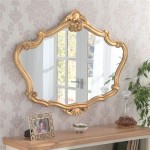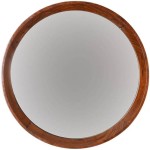Designing Your Own Bathroom Mirror: A Comprehensive Guide
The bathroom mirror is more than just a reflective surface; it is a focal point that significantly impacts the room's aesthetic and functionality. A well-chosen mirror can enhance lighting, visually expand the space, and contribute to the overall design scheme. Designing a custom bathroom mirror allows for complete control over these aspects, ensuring the perfect fit for individual needs and preferences.
Rather than settling for standard, mass-produced options, designing a bespoke mirror provides the opportunity to create a unique and personalized element within the bathroom. This article explores the various considerations involved in crafting a custom bathroom mirror, from initial planning and design to material selection and installation.
Defining the Mirror's Purpose and Style
The first step in designing a custom bathroom mirror involves defining its primary purpose. Is the mirror primarily for practical grooming tasks, decorative enhancement, or a combination of both? Understanding this distinction will guide subsequent design decisions. A mirror intended primarily for grooming should be positioned at an appropriate height and size to provide a clear and unobstructed view, while a mirror intended for decorative purposes can prioritize aesthetics and artistic expression.
Style considerations are equally crucial. The mirror's style should complement the overall design of the bathroom. Contemporary bathrooms often benefit from sleek, minimalist mirrors with clean lines and frameless designs. Traditional bathrooms may call for more ornate mirrors with decorative frames made from materials such as wood or metal. Transitional styles can incorporate elements of both, striking a balance between classic and modern aesthetics. Consideration should be given to the existing fixtures, color palette, and overall ambience of the bathroom to ensure the mirror seamlessly integrates into the space.
Furthermore, the size and shape of the mirror should be carefully considered in relation to the size and layout of the bathroom. A large mirror can visually expand a small bathroom, creating a sense of spaciousness. However, in a larger bathroom, a smaller, more decorative mirror may be more appropriate. The shape of the mirror can also contribute to the overall design. Rectangular mirrors are a classic choice, while round or oval mirrors can add a touch of softness and elegance. Asymmetrical shapes can create a more modern and artistic statement.
Material Selection: Choosing the Right Components
The selection of materials is paramount to the durability, aesthetics, and overall quality of the custom bathroom mirror. The mirror itself typically consists of a glass substrate coated with a reflective backing. While standard glass mirrors are common, options such as low-iron glass can provide enhanced clarity and color accuracy. Low-iron glass contains a lower concentration of iron oxide, resulting in a clearer, less green tint compared to standard glass. This is particularly important for applications where color accuracy is critical, such as applying makeup or shaving.
The framing material, if desired, offers another opportunity for customization. Wood frames can add warmth and character, while metal frames offer a more contemporary and industrial aesthetic. Wood frames can be crafted from various types of wood, each with its own unique grain pattern and color. Common choices include oak, maple, cherry, and walnut. The wood can be stained or painted to match the bathroom's color scheme. Metal frames, on the other hand, are available in a range of finishes, such as brushed nickel, polished chrome, and oil-rubbed bronze. The choice of finish should complement the other metal fixtures in the bathroom, such as faucets and showerheads.
Beyond the frame, other material considerations include the type of adhesive used to secure the mirror to the wall and any decorative elements that may be incorporated into the design. High-quality mirror mastic is essential for ensuring a secure and long-lasting bond. Decorative elements can include mosaic tiles, glass beads, or even integrated lighting. The careful selection of these materials will contribute to the overall aesthetic and functionality of the custom bathroom mirror.
The thickness of the mirror glass is yet another crucial aspect to consider. Thicker glass, such as 1/4 inch (6mm), is generally more durable and less prone to warping or distortion than thinner glass. This is particularly important for larger mirrors or mirrors that will be subjected to frequent use or cleaning. While thicker glass may be more expensive, it can provide a longer lifespan and improved optical performance.
Incorporating Lighting and Technology
Lighting is an integral component of any bathroom mirror design. Integrating lighting directly into the mirror can provide optimal illumination for grooming tasks and enhance the overall ambience of the bathroom. There are several lighting options to consider, each with its own advantages and disadvantages. Backlit mirrors, where light emanates from behind the mirror, create a soft and diffused glow that is ideal for creating a relaxing and spa-like atmosphere. Front-lit mirrors, with lights positioned around the perimeter of the mirror, provide more direct and task-oriented illumination.
The type of light source is also an important consideration. LED lighting is the most energy-efficient and long-lasting option, offering a range of color temperatures to suit individual preferences. Warm white light (around 2700-3000K) creates a cozy and inviting atmosphere, while cool white light (around 4000-5000K) provides a brighter and more focused illumination. Consider the color rendering index (CRI) of the light source, which measures the accuracy with which the light renders colors. A higher CRI (above 80) is generally preferred for grooming tasks, as it allows for more accurate color perception.
The incorporation of technology can further enhance the functionality and convenience of the custom bathroom mirror. Mirrors with integrated defoggers prevent condensation from forming on the surface, ensuring a clear reflection even after a hot shower. Touch-sensitive controls allow for easy adjustment of lighting levels and other features. Some mirrors even incorporate Bluetooth connectivity, allowing users to stream music or make phone calls while getting ready.
Smart mirrors are an increasingly popular option, offering a range of advanced features such as weather updates, news headlines, and even personalized fitness tracking. These mirrors typically feature a built-in display screen that overlays information onto the reflective surface. While smart mirrors can add a touch of futuristic flair to the bathroom, it is important to consider their cost and whether the added features are truly necessary.
The positioning of the lighting is also crucial. Sidelighting, where lights are positioned on either side of the mirror, is generally considered the most flattering and functional option, as it minimizes shadows and provides even illumination. Overhead lighting can create harsh shadows and should be avoided if possible. The height and spacing of the lights should be carefully considered to ensure optimal illumination for users of different heights.
Finally, it is important to ensure that all electrical components are installed in accordance with local building codes and safety regulations. It is highly recommended to hire a qualified electrician to handle the wiring and installation of any integrated lighting or technology features.
Designing a custom bathroom mirror requires careful planning and consideration of various factors. By defining the mirror's purpose and style, selecting the right materials, and incorporating appropriate lighting and technology, it is possible to create a unique and functional element that enhances the overall design of the bathroom.

Mirror Frame Diy How To Update A Basic Bathroom Our Faux Farmhouse

Diy Bathroom Mirrors Customize Your Own Delta Faucet
Bathroom Design Quick Tip Where To Place The Mirror When Your Sink Is Off Center Designed

Mirror Frame Diy How To Update A Basic Bathroom Our Faux Farmhouse

How To Frame A Mirror

Custom Bathroom Mirrors Creative Mirror Shower

20 Creative Diy Mirror Frame Ideas To Inspire Your Next Project Bathroom Mirrors Makeover

12 Unique Bathroom Mirror Design Ideas Designcafe

51 Bathroom Mirrors To Complete Your Stylish Vanity Setup

20 Stylish Bathroom Mirror Ideas








